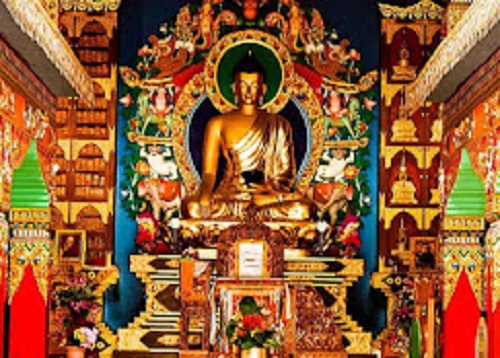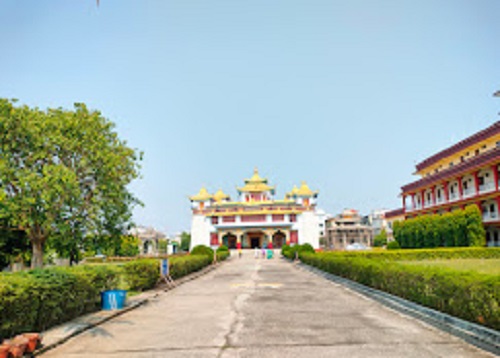Inside Area

Inside the Palyul Namdroling Temple in Bodh Gaya, visitors are welcomed into a peaceful and sacred atmosphere. The main prayer hall is beautifully decorated with traditional Tibetan art, colorful murals depicting the life of Buddha, and symbols of the Nyingma tradition. At the center stands a magnificent golden statue of Lord Buddha, surrounded by smaller statues of important masters and deities. The air is filled with the calming sounds of chanting monks and the gentle flicker of butter lamps. Long rows of cushions are arranged for monks during prayer sessions, and the walls are lined with sacred texts wrapped in cloth. Prayer wheels and thangka paintings add to the spiritual ambiance. The entire space is designed to inspire meditation, devotion, and reflection. Visitors often sit quietly, absorb the peaceful energy, and experience the deep spiritual essence that flows through this sacred temple in the heart of Bodhgaya.
Other Attractions
Apart from the peaceful and spiritual environment inside the Palyul Namdroling Temple, there are several attractions nearby that enhance the visitor’s experience. The temple is located close to the Mahabodhi Temple, the most important pilgrimage site where Lord Buddha attained enlightenment. Visitors often explore both these sacred places in one trip. The Bodhi Tree, just a short distance away, is another major draw for pilgrims and tourists. Surrounding the temple are monastic institutes, prayer halls, and Tibetan-style stupas that offer insight into Buddhist culture and education. Colorful prayer flags, well-maintained gardens, and quiet walking paths add to the beauty of the area. Many people also visit nearby temples built by countries like Thailand, Japan, Bhutan, and Vietnam, making the region a global center for Buddhist culture. Together, these attractions offer a unique blend of spirituality, culture, and architectural beauty around the Palyul Namdroling Temple. Ask ChatGPT

Distance From
Gaya Railway Station
The distance from Gaya Railway Station to Palyul Namdroling Temple in Bodhgaya is approximately 16 kilometers

Gaya Airport
The distance from Gaya Airport to Palyul Namdroling Temple in Bodhgaya is around 12 kilometers

Gaya Bus Stand
The distance from Gaya Bus Stand to Palyul Namdroling Temple in Bodhgaya is approximately 17 kilometers

Our Review
Visiting the Palyul Namdroling Temple in Bodhgaya was a truly peaceful and enriching experience. The moment we entered, we were greeted by the calm and spiritual atmosphere that surrounds the temple. The architecture is stunning, reflecting traditional Tibetan style with intricate paintings, golden statues, and colorful decorations that immediately catch your eye. Inside the prayer hall, the serene chanting of monks and the sight of butter lamps glowing softly created a deep sense of inner peace. The temple is very well maintained, and the environment feels both sacred and welcoming. We especially appreciated the quiet surroundings and the opportunity to sit, reflect, and connect with the deeper teachings of Buddhism. It’s not just a place of worship—it’s a space where the soul feels calm. For anyone visiting Bodhgaya, this temple is a must-visit spot, offering spiritual beauty and cultural richness in one peaceful setting.
